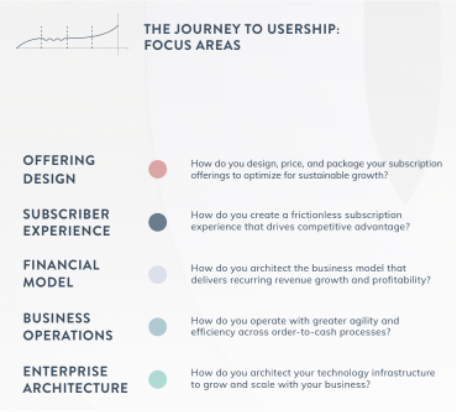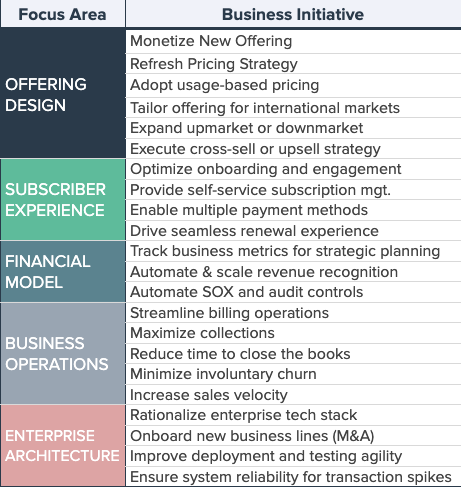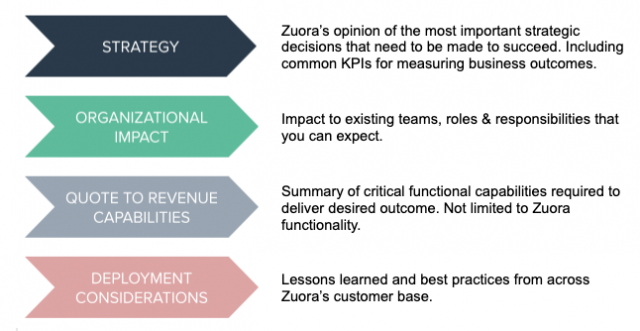By Jon Brown, Director of Customer Strategy
At Zuora, we’ve worked with thousands of subscription businesses and studied millions of data points across the world’s leading companies. We’ve seen patterns of success, pitfalls to avoid, and lessons that other companies can learn from. We’ve compiled all of these learnings into a blueprint that outlines the stages your company will go through and the areas you need to focus on to reach the holy grail of the Subscription Economy: long-term customer loyalty and sustainable, predictable revenue growth. We call that blueprint: “The Journey to Usership.”
For more details on the concepts in the Journey to Usership framework, you can check out the whitepaper here. This blog post is intended to give you an idea of how we here at Zuora leverage the framework to guide our customers on their own journeys. It’s what you can expect when you become a Zuora customer, and it’s something you won’t find anywhere else.
Part 1: Focus Areas and Initiatives – Working Towards Outcomes
When you’re assigned a Customer Success Manager at Zuora, the first thing they’ll want to do is align on the outcomes you want to deliver for your business. This process isn’t always as straightforward as it may seem. Quote-to-revenue is complex, and there are often many competing priorities. You have a new product launch coming up, but you’re also trying to IPO. Your customers are demanding more flexibility, but that breaks your revenue recognition. Your sales team hates their quoting tool, but your CFO wants a new pricing strategy rolled out. The J2U Framework can help you navigate these situations, and starts simple with five Focus Areas.
The long-term goal should always be for your company to excel at all five of these focus areas. But how you maintain that excellence becomes a function of resource constraints and the needs of your business. With that lens in mind, weighing the focus areas against each other can be a great mental exercise for prioritization and driving alignment within your business. One of the first things your Customer Success Manager at Zuora will ask you is: Which of the “Five Focus Areas” matter most to you and your business right now?
| Key Question: Which focus area offers your company the biggest opportunity to deliver business value? |

Once you’ve considered the focus areas, it’s time to dig in and better define the specific outcome that will define your quote-to-revenue success. For that, the next level in the J2U Framework is the concept of a “Business Initiative.”
Within the five focus areas we’ve identified a total of twenty-two business initiatives that represent common outcomes supported by Zuora. The “initiative” is the atomic unit around which your entire J2U toolkit is organized. Once you’ve identified the initiatives that are most relevant to your desired outcomes, it’s time to start hammering out the details of the plan to deliver. Enter J2U Playbooks….
Key Question: Which initiatives are the most important for your business right now?


Part 2: Playbooks & Success Planning:
Each of the J2U Business Initiatives represent a well-worn path through which Zuora has helped thousands of our customers deliver quote-to-revenue outcomes. J2U Playbooks are collections of actionable guidelines and best practice recommendations distilled from that experience. Not only do playbooks address required functional capabilities, but strategic, organizational, and deployment considerations as well. As such, each playbook is organized around those four key components.
J2U Playbook Components:

With your initiatives identified in Part 1, the next step is for your CSM to walk you through the relevant J2U Playbooks for those initiatives. The goal of a J2U Playbook “session” is to align on a clear KPI to measure your desired outcome and identify gaps and/or blockers on your way towards delivering it. The actions required to close those gaps and remove those blockers becomes your Zuora J2U success plan.

Part 3: Regular Business Reviews
With a J2U success plan in place, the focus turns towards execution and mutual accountability. Regular Business Reviews represent an opportunity to reflect on the work performed against a J2U success plan, evaluate the status of desired outcomes and course correct as needed.
Generally performed quarterly, a typical business review can consist of any of the following topics:
- An update on the KPIs established and any other relevant Zuora usage data, including benchmarking.
- A review of work completed since the last review and a reflection on areas of improvement.
- Applying a critical eye to the forward-looking plan to ensure everything is still on track to deliver the originally intended business outcomes.
- Declaring victory on an outcome delivered, and deciding on the next initiative to tackle.
Every EBR is a major milestone in your business’s Journey to Usership. They are where the victories are celebrated and defeats analyzed. They are the place where those big, meaty topics finally get aired and discussed. Given all the integration points of a typical deployment, a Zuora EBR frequently is the meeting where those teams who “never talk to each other but really should” actually….talk to each other! When done right, Business Reviews with Zuora, powered by the Journey to Usership framework, will be some of the most valuable meetings you have all year.
Conclusion:
You should now have a good sense of how the Journey to Usership is more than just a conceptual framework for us at Zuora. It truly is the lifeblood of how we serve our customers. Partnering with Zuora won’t just bring you industry-leading technology, but an opportunity to truly change your business for the better.
If you’re an existing Zuora customer, your Customer Success Manager has likely already kicked-off this process with you. That said, don’t hesitate to reach out if you have more questions! If you’re not a Zuora customer yet and want to learn more, click the “Talk to Sales” button above. Either way, we look forward to helping you and your business advance on the Journey to Usership soon.